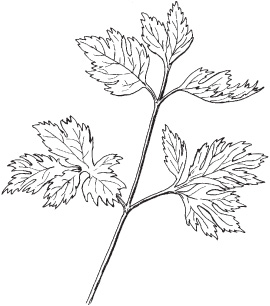Growing & Using Cilantro
Glenn Andrews
Introduction
What is cilantro? Good question! The quick answer is that cilantro, also known as coriander, is an amazing two-for-the-price-of-one herb and spice.
In this country, weve long been familiar with the spice known as coriander, which is the ground seed of the plant Coriandrum sativum. And now, just in the last few years, weve been discovering the green, leafy herb that grows from the seed. We call it cilantro.
Were centuries behind in our discovery of cilantro! For hundreds of years its been used in the cooking of India, Mexico, Thailand (where the root is also prized) and much of the rest of Asia, Spain, Portugal, Africa, Russia, China, and the Middle East (where many believe it originated).
So what took us so long? I think it was a combination of several factors. To begin with, as a nation we have not (until recently) been notably adventurous where food is concerned. Also, most of our settlers originally came from England and the Germanic parts of Europe not hotbeds of cilantro usage.
I think the main thing that stopped us, though, is the undeniable fact that cilantro is an acquired taste. Most people actually hate it when they first try it. In truth, the taste was a terrible blow to me as well. I first read about the joys of cilantro in the works of Elena Zelayeta, a great cook of San Francisco. She wrote about it so glowingly that when she suggested planting some coriander seed from the spice cabinet, I did, and eagerly waited till the resulting greenery was ready to taste.

The coriander plant with seed heads

A leaf of cilantro
I finally broke off a few leaves and popped them into my mouth and absolutely despised the taste! In my disillusionment, I refused to try the herb again until a good friend served me the marvelous chicken salad youll find on page 16. Whats the unusual taste in this? I asked. You know the answer: cilantro!
And thats the key to learning to love cilantro. Try small amounts of it at first, combined with other ingredients. Most salsas take this approach, using small amounts with spicy peppers. If you like salsa, you are halfway there. It might also help if you try cilantro cooked at first, as opposed to raw. I can just about promise that you, too, will come to love it perhaps even crave it from time to time!
What an amazing plant cilantro is. Its entirely different from any other I can think of. Green, it has one taste. The dried green parts no taste at all. The dried seed has an entirely different effect. And the roots still another!
Whats the Real Name?
Cilantro? Coriander? How about one of these names: Chinese parsley or culantro or culantrillo or koyendoro or pak chee or collantro or yuen-sai or kindzi? Theyre all names for the same bright green, leafy plant were gradually coming to know in this country as cilantro. Any food used in so many parts of the world has to have lots of varying names.
If you feel you really have to pin down your cilantro, you can always play safe and use the botanical name, Coriandrum sativum. Or you can use the scientific name of another variety of cilantro, hard to find, yet worthwhile because of its slower bolting: C. sativum santo. (Several producers claim to have seed that is slow to bolt. See page 30: some of these seed suppliers might have just what you need.)
Growing Cilantro
Cilantro, like all herbs, is best at its very freshest. And the best source for fresh cilantro is your own backyard.
Seed versus Transplants
Whats the best way to approach growing cilantro starting from seed or buying and using plants?
Well, plants are available, from mail-order sources and in garden stores (and even supermarkets from time to time), but I cant really see any purpose in buying them. By the time a plant reaches you, its life is just about over! So start with some seed (yes, even the dried coriander seed in your spice cabinet might sprout and grow fine cilantro.)
But if youre really in a rush to use some cilantro in your cooking, you can always buy some cut sprigs tied in bundles or in plastic bags. You can find these in most supermarkets these days. Quite often, youll find that the cilantro in the supermarket still has its roots attached. This is the best sort to buy. To begin with, the roots will help the herb last longer. But theres more to it than that. The roots are not only edible, but also highly prized at least by the citizens of Thailand! (Be sure to try the Thai recipe on page 17 so you can get an idea of the pleasant taste of the roots.)
So start your plants from seed. Germination is fast and the rewards are well worth the effort.
Basic Growing Tips for Cilantro
Plant the seed from 1/8 to 1/4 inch deep in light, well-drained soil. Keep uniformly moist until germination, which will take place in 14 to 16 days.
Conventional wisdom (and the instructions on most seed packets) will tell you the plants should be spaced 18 inches apart. I feel that this goes back to the days when cilantro was fairly unknown in this country and the plant was almost always grown as coriander, for its seed.
My advice to you is to plant the seeds much closer together than that. I wouldnt put them any farther apart than 2 inches. Think of it as a loose-leaf lettuce say, a Black-seeded Simpson. You want to be able to use the young plants as you thin them. In other words, start by picking every fourth little plant, then every third, then every second. If you want, you can let the remaining plants grow to their full height of 2 to 3 feet and harvest the coriander seed. (If you become fond of the roots, though, they are best harvested before the plant goes to seed.)
Decisions, Decisions
Youll have to figure out if you want to grow your cilantro for seed (in which case call it coriander) or for its green leaf. Or better yet for both.
Because cilantro is so very quick to bolt (produce seed stalks and seed), raising it for seed is easy. Just plant it in summer in full sun, keep it on the dry side, dont feed it (or not much, at any rate), and youll soon have seed.
On the other hand, to achieve the largest possible amount of greenery from your cilantro, go in the other direction: Plant in spring or fall in a partly shady location, and keep it nicely watered and fed. A water-soluble fertilizer such as sea kelp (an organic 4-4-4 seaweed fertilizer) or Miracle-Gro is a good idea for cilantro. Nitrogen (the first number in fertilizer formulas) produces lush foliage, so make sure your fertilizer has at least as much nitrogen as phosphorus and potassium (the second and third numbers, respectively). It helps, too, if you choose a strain of cilantro that the grower claims is slow to bolt (see the list of seed sources on page 30).
Of course, as with any annual herb, pinching out flower stems (in this case, the thick stems with fennel-like foliage) as they appear will help slow down bolting. Any annuals one aim in life is to reproduce itself. If you let it produce seed, it will consider its work done, turn up its toes, and die. But if you thwart it dont let it create seed it will keep on growing.
If youre aiming for both greenery and seed, I suggest you start out using the conditions suitable for greens production, then just let some of the plants go to seed, which they certainly will!




